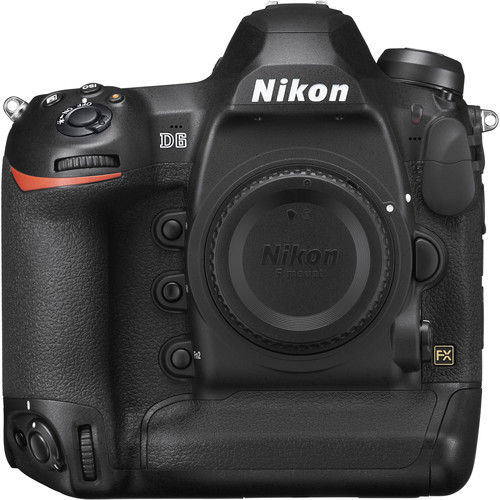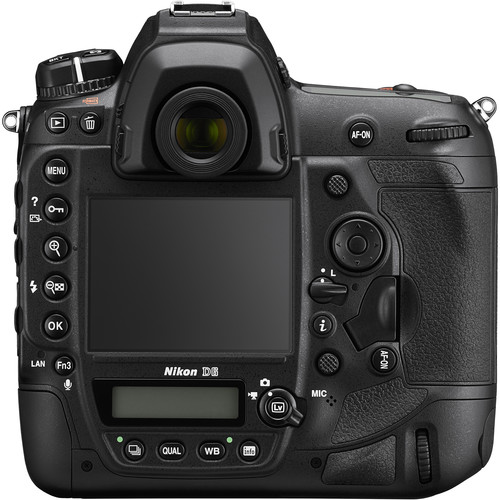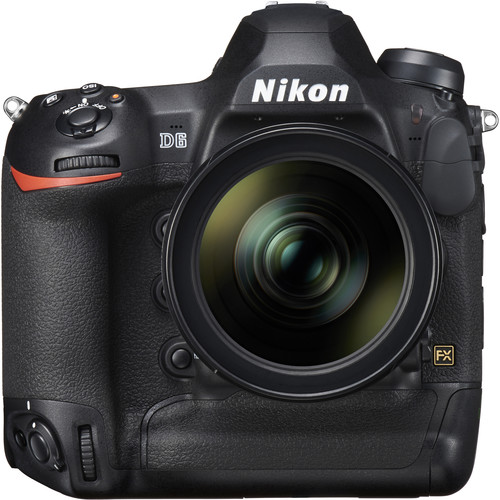Nikon D6 DSLR Camera (Body Only)
- 20.8MP FX-Format CMOS Sensor
- EXPEED 6 Image Processor
- Multi-CAM 37K 105-Pt. All Cross-Type AF
- 14 fps Shooting, Extended ISO 3280000
- 4K UHD Video Recording at 30 fps
- 3.2″ 2.36m-Dot Touchscreen LCD Monitor
- 0.72x-Mag. Pentaprism Viewfinder
- 180k-Pixel RGB Sensor and Group Area AF
- Built-In Wi-Fi, Bluetooth, and GPS
- 1000 Base-T Gigabit Wired LAN Support
₨1,761,000
The peak of Nikon‘s DSLR lineup, the D6 is a no-holds-barred camera with a focus on speed, performance, reliability, and precision. Adept in both photo and video realms, the D6 revolves around a 20.8MP FX-format sensor and an EXPEED 6 image processor that enables an impressive 14 fps continuous shooting rate, a native sensitivity range from ISO 100-102400 (expandable up to ISO 3280000), and UHD 4K video recording at 30 fps. When working with stills, a revised high-density Multi-CAM 37K autofocus system features 105 cross-type points that improve focusing precision and speed, and with 1.6x greater frame coverage, the need to recompose while shooting is greatly reduced. This focusing system also works with 17 customizable Group Area AF patterns to suit working in cluttered or busy scenarios or with fast-moving subjects.
As Nikon’s flagship DSLR, the D6 is, of course, a tough camera, too. Its magnesium alloy construction pairs with extensive weather sealing to resist dust and moisture, and a reinforced shutter mechanism has been tested for 400,000 shutter cycles. For viewing, there is a large pentaprism optical viewfinder with 0.72x-magnification as well as a rear 3.2″ 2.36m-dot touchscreen LCD. Additionally, the body design incorporates dual CFexpress Type B memory card slots, which offer flexible file saving capabilities, and internal Wi-Fi and Bluetooth also benefit file saving needs as well as afford remote shooting control. For more robust connectivity, the D6 supports wired and wireless LAN connections, too. And, built-in GPS is featured, as well, for in-camera geotagging applications. In familiar form, too, the D6 also has a variety of configurable Function buttons across the body and an integrated vertical grip supports working in both horizontal and vertical shooting orientations.
20.8MP FX-Format CMOS Sensor and EXPEED 6 Image Processor
The FX-format 20.8MP CMOS sensor is paired with the EXPEED 6 image processor to offer a proven mixture of high sensitivity, nuanced image quality, and fast overall performance. At native values, a sensitivity range from ISO 100-102400 permits working in a broad array of lighting conditions, an can be further expanded to ISO 50-3280000 (Lo 1 to Hi 5) to handle the most challenging of situations. The mixture of resolution and sensor size also contributes to clean image quality and smooth color transitions with reduced noise throughout the sensitivity range.
In addition to benefitting image quality, the EXPEED 6 processor also affords a wealth of speed throughout the camera system, including a top continuous shooting rate of 14 fps for up to 200 consecutive frames. For sound-sensitive situations, a silent 10.5 fps rate can be used for discreet shooting and, if choosing to work in a lower resolution and in live view, up to 60 fps shooting is possible at 2MP or 30 fps shooting at 8MP.
105-Point All Cross-Type Multi-CAM 37K Autofocus System
Dubbed “the most powerful AF in Nikon’s history,” the Multi-CAM 37K autofocus system uses an intelligent array of 105 all cross-type points to quickly and accurately achieve focus across the frame and in a variety of lighting conditions. This high-density system allows photographers to set focus almost anywhere within the frame in order to avoid recomposing. This unique design reduces the area of non-AF-sensitive areas in order to make the effective coverage 1.6x greater than in previous models, which allows for more accurate and faster focusing across the frame, with both still and moving subjects. When working with moving subjects, 17 custom Group Area AF settings can be used to set and maintain focus on subjects featuring busy backgrounds or fast subject movement. Benefitting the use of super telephoto lenses and teleconverters, 15 of the points are compatible with an effective aperture of f/8 and all 1053 points support working with effective apertures of f/5.6 or brighter.
Complementing the abundance of focusing points is a dedicated AF engine, which offers quick response times to benefit tracking fast and randomly moving subjects, even at the top 14 fps shooting rate. The AF engine also contributes to enhanced focusing sensitivity, with the ability to focus at -4.5 EV for working in very dark, low-contrast situations.
Furthering the versatility of the focusing system, seven different AF-area modes can be selected to support varying types of subject matter:
- Single-Point AF: The camera uses a single point to find focus.
- Dynamic-Area AF: Available with 9, 25, 49, or 105-point selections, this mode uses a primary single focus point to lock onto focus, and then makes use of the surrounding points for maintaining focus while tracking erratically-moving subjects.
- Group-Area AF: This mode treats smaller groups of AF points as a single point for a wider field of recognition and is well-suited to tracking faces or other detailed subjects.
- 3D-Tracking: Using a subject’s color information, this mode utilizes all 105 points to maintain focus on a moving subject while half-pressing the shutter button.
- Auto-Area AF: This mode makes use of all 105 points to quickly identify the main subject, and then prioritizes recognized faces as portrait subjects in any AF servo mode.
In addition to the range of AF-area modes, an AF lock-on function can also be used to improve subject tracking performance and can be adjusted by two parameter—quick or delayed blocked shot AF response and erratic or steady subject movement. By configuring these settings, the AF performance can be optimized to handle a wide variety of subject movement types.
Lastly, a unique auto AF fine-tune function can be employed to ensure the best possible focus for each mounted lens. Rather than relying on photographing distance charts, this function lets you achieve precise focus manually in live view, and then have the AF system calibrate itself to the fine-tuned focus position in order to alleviate front- and back-focusing issues.
| Brands |
|---|
Based on 0 reviews
Only logged in customers who have purchased this product may leave a review.









There are no reviews yet.